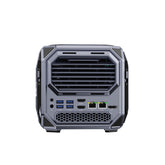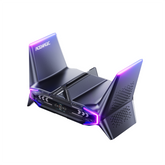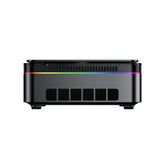Top Software List to Boost Efficiency and Workflow in 2025

Modern office work is less about how long you sit at a desk and more about how effectively you use your time. Even with strong hardware, productivity suffers when information is scattered or tasks lack structure. The right software can fix that — giving you tools to plan clearly, collaborate smoothly, and automate what slows you down. This guide explores practical applications that improve efficiency and overall work quality across different stages of everyday work.
Task and Time Management Software
When work expands beyond a single to-do list, structure becomes essential. Task and time management apps help you translate plans into daily action, clarify priorities, and reduce the stress of multitasking.
Notion
Ever feel like your notes, ideas, and deadlines are scattered across different tools? Notion solves that by uniting everything in one flexible workspace. You can organize tasks, draft meeting notes, and build databases to track goals or client information. It adapts easily — whether you manage solo projects or coordinate a small team. Notion helps replace cluttered folders and disjointed apps with a clear structure, so you spend less time searching and more time creating.

Todoist
Todoist is built for people who want a clean and reliable way to plan their day. Adding new tasks takes seconds, and each one can be categorized, prioritized, or set to repeat. The visual layout keeps your workload visible at a glance, helping you focus on what actually matters. Over time, Todoist becomes less of a to-do list and more of a personal routine manager — one that keeps you consistent without overcomplicating the process.

Trello
Trello turns project management into something visual and intuitive. Each board represents a workspace, and each card tracks a single task or idea. Moving cards from “In Progress” to “Done” gives an immediate sense of progress, which is motivating on busy days. Teams appreciate Trello because it reduces confusion about responsibilities — everything from attachments to comments lives in one place. It transforms collaboration from scattered updates into a clear, shared overview.

Google Calendar
Google Calendar remains one of the simplest yet most powerful ways to coordinate time. It synchronizes across all devices and integrates with email and conferencing tools, allowing you to plan meetings or reminders without friction. Shared calendars help teams avoid overlapping schedules, while color coding and smart notifications make even complex agendas easier to manage. It’s less about marking dates and more about understanding how your time is spent.

TickTick
If staying focused is a daily struggle, TickTick offers a balanced approach to time and discipline. It combines a task list with a built-in Pomodoro timer, helping you break large projects into short, concentrated sessions. Each completed interval adds to a visual record of progress — small wins that keep momentum steady. This structure is ideal for anyone managing long days filled with context switching. By connecting tasks with focus cycles, TickTick helps turn productivity into a sustainable habit.

Communication and Collaboration Software
Strong communication keeps teams moving in the same direction. Even experienced professionals lose efficiency when updates, feedback, and files get buried in messages or multiple platforms. The tools below help teams stay aligned and reduce the chaos of scattered communication.
Slack
If your inbox feels like an obstacle instead of a resource, Slack can help. It organizes conversations by channels, separating discussions by topic or project. Real-time messaging keeps decisions moving quickly, while integrations with tools like Trello and Google Drive centralize information. The transparency of channels means fewer missed updates and clearer accountability. Slack turns team communication into something structured, searchable, and easy to maintain.

Microsoft Teams
Microsoft Teams combines chat, meetings, and document collaboration in one space. Integrated with Microsoft 365, it lets you edit files, schedule calls, and manage projects without switching apps. For companies that already rely on Outlook or SharePoint, it becomes the natural extension of daily work. Teams solves the problem of fragmented communication by giving everyone a shared environment — one place for messages, meetings, and materials.

Zoom
Zoom continues to be a dependable video-conferencing platform for remote and hybrid teams. Its reliability and straightforward setup make it a default choice for meetings of any size. Features like screen sharing, breakout rooms, and session recording support everything from quick check-ins to detailed workshops. Zoom keeps meetings smooth and consistent so teams can focus on content instead of connection issues.

Google Meet
Google Meet provides a lightweight way to host video meetings directly from your browser. Integration with Google Calendar makes scheduling simple, and automatic meeting links save time. It’s ideal for teams that value quick access and minimal setup. Google Meet reduces friction in daily communication by turning what used to be a multi-step process into a one-click connection.

Miro
When words aren’t enough to express ideas, Miro gives teams a shared visual space. It’s an online whiteboard for brainstorming, planning, or mapping workflows together in real time. Templates for flowcharts, mind maps, and sprint plans make it easy to start. Miro helps remote teams turn scattered thoughts into visual progress, ensuring creativity and structure coexist on the same board.

Creation and Productivity Software
Creative work thrives when tools get out of the way. Whether you design, write, or build, these applications make the process faster and more consistent without limiting your ideas.
Canva
Need to design a presentation or social post but don’t have time for complex software? Canva simplifies visual creation through ready-made templates and drag-and-drop editing. You can create everything from infographics to marketing visuals in minutes and share projects with teammates for instant feedback. Canva helps non-designers produce professional results while maintaining brand consistency and saving valuable time.

Figma
Figma is the preferred design platform for teams building digital products. It allows multiple users to work on the same interface, share updates, and exchange comments instantly. With version history and shared design libraries, it ensures accuracy across projects. Figma streamlines communication between designers and developers, replacing static hand-offs with live, editable prototypes.

Visual Studio Code (VS Code)
VS Code offers developers a responsive coding environment with deep customization. Its plugin ecosystem covers nearly every programming language, while built-in debugging and Git tools reduce setup time. Developers appreciate its stability even on compact systems like Mini PCs, where performance efficiency matters. VS Code keeps all essential tools — terminal, editor, and version control — within one window, minimizing distraction and maximizing momentum.

Grammarly
Grammarly acts as an unobtrusive writing assistant. It reviews grammar, tone, and readability in real time and offers concise explanations for every suggestion. Professionals who draft reports or correspondence daily can maintain accuracy without interrupting their workflow. Grammarly helps prevent small mistakes that undermine clarity and ensures that your writing remains polished across different contexts.

ChatGPT
ChatGPT adds flexibility to creative and analytical work. It can help generate ideas, summarize long information, or reformulate sentences for clarity. Many professionals use it to speed up everyday writing or explore alternative phrasing when explaining complex topics. It supports your workflow by turning rough concepts into usable drafts faster, leaving you more time for decision-making and refinement.

System Optimization and Automation Software
Repetitive work consumes focus and energy. Automation and optimization tools handle these smaller tasks so you can concentrate on higher-value activities.
Microsoft Power Automate
Microsoft Power Automate links applications through custom workflows. It can save email attachments to cloud storage, trigger alerts from spreadsheet changes, or send form data directly to project boards. It integrates smoothly with Microsoft 365, letting organizations streamline internal operations without coding. Power Automate eliminates small time losses that add up throughout the day.

Zapier
If you’re constantly switching between platforms to move information, Zapier can take that load off your plate. It connects thousands of web services and automates data transfers between them — for example, turning form responses into CRM entries or syncing files between storage accounts. For freelancers and small teams, Zapier quietly keeps systems synchronized, reducing manual effort and the risk of oversight.

Ditto Clipboard Manager
Ditto expands your clipboard into a searchable memory of everything you’ve copied. You can recover old snippets, text, or images without repeating the same actions. It’s especially useful when comparing data or collecting notes from multiple sources. Quiet but effective, Ditto saves time in ways that become obvious only after you start using it.

ShareX
ShareX combines screenshot capture, screen recording, and quick sharing. You can define shortcuts, annotate images, and upload results automatically to cloud services or internal folders. For support teams, developers, and educators, it simplifies visual communication by cutting extra steps between capture and delivery. ShareX turns documentation into a fast, precise task rather than an interruption.

Conclusion
Efficiency isn’t about using more tools — it’s about finding the ones that remove barriers from your routine. The software in this guide covers every stage of office work, from planning to collaboration and automation. Together, they help you focus on what matters while reducing distractions that waste time.
Technology should adapt to your working style, not reshape it. Try combining a few of these tools and see how they fit your rhythm. Keep this guide bookmarked — the right setup can make your workspace feel lighter, faster, and genuinely more productive.
Great software brings structure, but hardware still defines how smoothly those tools perform. A compact, high-performance Mini PC or a lightweight laptop can make multitasking, screen sharing, and creative work feel effortless. Faster storage, stable connectivity, and quiet operation all help these productivity tools run at their best. If your current setup slows you down, upgrading your device may be the simplest way to unlock the full potential of the software you use every day.
| Powerful and Professional |
Efficient and Compact |
Balanced and Versatile |
|---|---|---|
| Intel® Core™ i9-11900H | AMD Ryzen™ 5 7430U | AMD Ryzen™ 7 5700U |
| Intel® UHD Graphics for 11th Gen Intel® Processors | AMD Radeon™ Graphics | AMD Radeon RX Vega 8 |
| Wi-Fi 6E + BT5.2 | Wi-Fi 6 + BT5.2 | Wi-Fi 6 + BT5.2 |
| ACEMAGIC M1 Mini PC | ACEMAGIC K1 Mini PC |
ACEMAGIC AM06 Pro Mini PC |
 |
 |
 |
| Buy Now | Buy Now | Buy Now |






